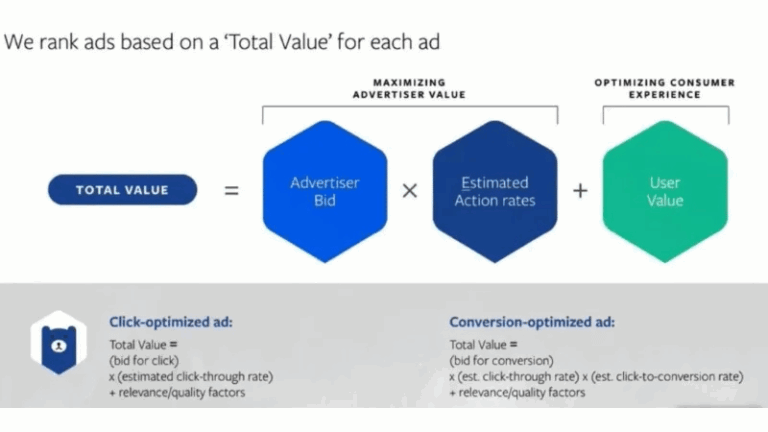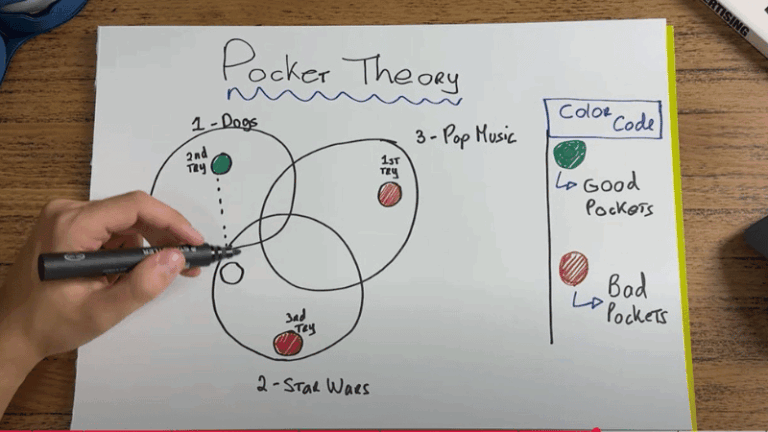Your Facebook ads can’t be delivered to potential customers even though you’ve spent a lot of money on your campaign. Many advertisers explain that you should bid high because the Facebook algorithm works like an auction system. It sounds simple: if you bid higher than your competitor, your ad will win a greater market share and be delivered to more customers. It’s like a land auction – the highest bidder gets the “ad land” on a user’s feed and the right to display their ad.
But in reality, it’s not that simple, as many major brands have spent a ton of money on advertising with very poor results. So what’s the reason? This blog will not only explain the Facebook algorithm but also provide solutions to help you apply the correct algorithm for a high-impact Facebook ad campaign.
Understanding how the Facebook Ads mechanism works
First, I want to talk about Facebook ad bidding, a crucial part of a campaign’s success.
The bidding formula

Here is the formula Facebook uses to determine how an ad auction plays out:
Final Bid = Advertiser Bid x Estimated Action Rate + Ad Relevance and Quality Score.
I know that looks a little complicated, but Meta doesn’t just provide a dry formula; they also offer a basic explanation of each component. So, let’s take a look.
The advertiser’s bid is the most straightforward part—if you’re using a manual bidding strategy, you’ll have to enter your desired bid yourself. However, if you’re like most people, you use Facebook’s automatic bidding strategy (also known as Lowest Cost), which is the amount Facebook automatically sets for you. And to optimize Facebook ads, in 90% of cases, I would advise everyone to use Facebook’s automatic bidding rather than manual bidding.
When you select this option, Facebook will decide the auction amount for you, based on what it thinks will get you the maximum number of conversions at the lowest possible cost. In most cases, this is exactly what we want. So, the first factor is quite easy to understand. What about the other two?
- What is the estimated action rate?
- What do relevance and quality score mean?
Now, let’s start with relevance and quality score.
Ad quality score
Relevance and quality score is a factors that Meta uses to optimize the user experience when displaying ads. A simple way to understand it is this: Facebook, as a business, makes money by selling ad space and showing ads to users. However, if they show too many low-quality or overly aggressive ads, they run the risk of annoying users and driving them away from the platform. If users get annoyed and stop using Facebook, there will be no one left for them to sell ads to, and their revenue will plummet.
So, like every other social media platform, Facebook prioritizes maximizing user retention time. Facebook’s goal is to keep you on the platform for as long as possible because the longer you stay, the more ads they can show you. As you know, Facebook’s biggest revenue source is its advertising services. By retaining more users, Facebook has more opportunities to attract ads from businesses that want to advertise on its platform.
This means Facebook has to pay close attention to the user experience when they are “hit” with an ad. When an advertiser submits a new ad creative, Facebook meticulously checks to ensure it complies with policies. But it doesn’t stop there—even if your ad is approved, they will still score it based on relevance and quality to evaluate whether that ad provides a positive or negative experience for users.
Facebook doesn’t disclose the specific formula for this score, but it is likely related to user feedback on the ad, such as likes, comments, video watch time, as well as the frequency with which users hide the ad or mark it as “not interested.”
Now we want to address the third factor—and also the most ambiguous of the three—the Estimated Action Rate.
Estimated action rate
You can understand this as the rate that Facebook estimates your ad will achieve its desired goal with each impression. The goal will differ depending on the campaign objective you choose—it could be lead generation, clicks, purchases, or any other objective.
A question many advertisers have is: How does Facebook know what this estimated action rate is? And how is it calculated?
If you’ve ever run an ad, you’ll know that an ad can be completely useless if it reaches the wrong audience but becomes a conversion machine if it’s shown to the right audience. So, is there a way to know if your ad has reached the right audience?
Here’s how Meta explains it:
“The estimated action rate is the likelihood that a specific person will interact with or take action on a specific ad.” In other words, it’s the probability that showing an ad to one person will lead to the result the advertiser wants.
(Note: Using tricks like “clickbait” or “engagement bait” will not improve ad performance.)
Tips for understanding potential customers’ needs on Facebook

In the process of consulting with clients at Optimal Agency, our team receives a lot of questions like: How does Facebook choose who to show ads to?
During the ad campaign setup process, you can customize your target audience in great detail, from gender to age and demographics. However, the Facebook social network uses an interest attribution system to assign users to groups based on topics they are believed to be interested in. This interest attribution system from Facebook is often very inaccurate.
The example below will help explain this issue.
Here’s how to do it:
Step 1: Log in to Facebook.
Step 2: Click on your profile picture in the top-right corner.
Step 3: Go to Settings & privacy, then click Settings.
- From there, click on See more in Account Center on the left.
- Then select Ad Preferences → Ad Topics.
After following these steps, you will see the interests that Facebook has assigned to you. However, this is not necessarily accurate, as it is only temporary, based on your recent activity on Facebook.
Now, let’s get back to the question: How does Facebook choose who to show ads to?
The answer is that it uses machine learning to understand the needs of potential customers. So, what model is used to determine the most optimal audience?
School of thought 1: Pocket Theory
Imagine the large circles below represent groups of Facebook users, segmented by the interests they’ve been labeled with.

- Circle 1: People who like dogs
- Circle 2: Star Wars fans
- Circle 3: People who like pop music
Suppose you’re selling a product for dogs and you choose to target dog lovers—obviously, Facebook will select Group 1.
But Pocket Theory suggests:
When you choose to target an interest group, Facebook can’t show ads to the entire group, as it could contain 10–50 million people. Instead, Facebook selects a few random “pockets” within that group to test first.
School of thought 2: Creative Theory
Creative Theory means that instead of focusing heavily on the ad set level, we shift our focus to creating ad content. And working at the creative level means testing different ad creatives, with various variations inside each one. We test images, videos, carousels, different marketing angles, headlines, content, etc.
The goal here is:
We provide Facebook with as many variables as possible so its algorithm can find which content is most suitable for the audience it chooses to display to.
Facebook has clearly shown its preference for this approach through the launch of a new campaign type:
👉 Advantage+ Shopping campaigns—which no longer have a manual interest targeting option.
Final words
This blog post has provided a detailed explanation of how the Facebook Ads mechanism works. In addition, it has given you a lot of newly updated advertising knowledge to help you better understand the algorithm and how experts set up high-impact Facebook ad campaigns.